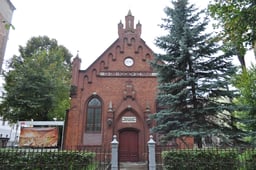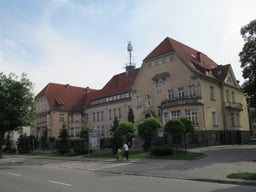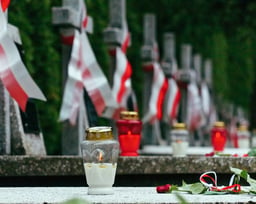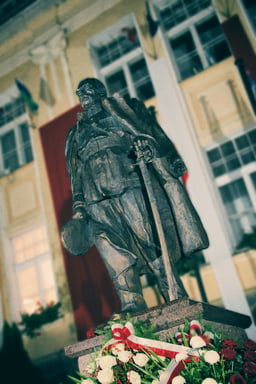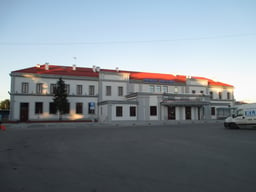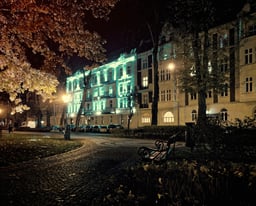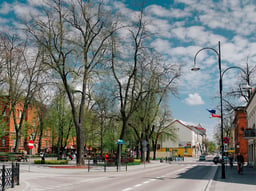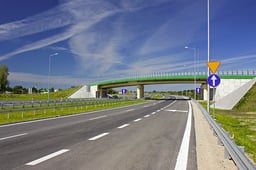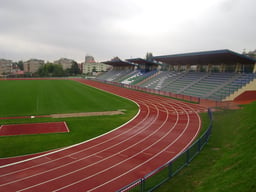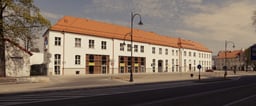Ełk
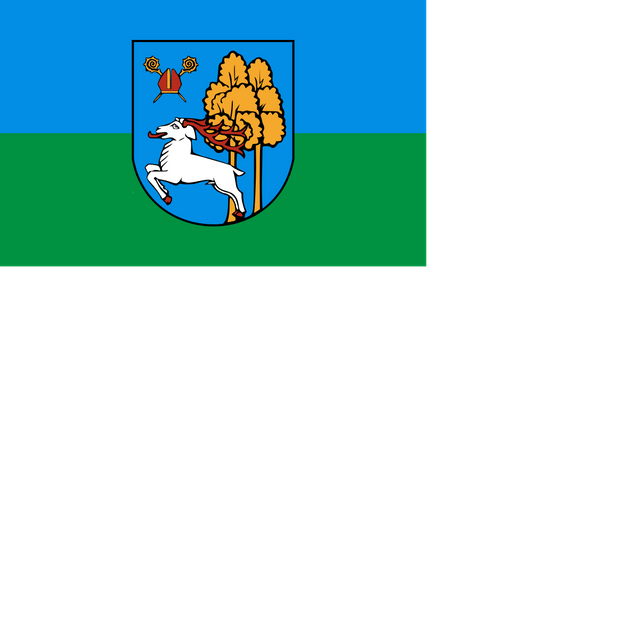
Ełk

Ełk | |
|---|---|
| |
| Coordinates:53°49′17″N 22°21′44″E [65] | |
| Country | |
| Voivodeship | |
| County | Ełk County |
| Gmina | Ełk(urban gmina) |
| Established | 1237 |
| Town rights | 1445 |
| Government | |
| • Mayor | Tomasz Andrukiewicz |
| Area | |
| • Total | 22.07 km2(8.52 sq mi) |
| Population (31 December 2017) | |
| • Total | 61,523 |
| • Density | 2,800/km2(7,200/sq mi) |
| Time zone | UTC+1 (CET) |
| • Summer (DST) | UTC+2 (CEST) |
| Postal code | 19-300 |
| Area code(s) | +48 87 |
| Car plates | NEL |
| Website | http://www.elk.pl [66] |
Ełk (Polish pronunciation: [ɛwk]; former Polish: Łek; German: Lyck ; Old Prussian: Luks; Lithuanian: Lukas), also spelled Elk in English, is a small city in northeastern Poland with 61,156 inhabitants (as of 2010). It was assigned to Warmian-Masurian Voivodeship in 1999, after belonging to Suwałki Voivodeship from 1975 to 1998. Ełk is the seat of Ełk County. It lies on the shore of Ełk Lake, which was formed by a glacier, and is surrounded by extensive forests. It is the largest city and unofficial capital of historical Masuria. One of the principal attractions in the area is legal hunting.
Ełk | |
|---|---|
| |
| Coordinates:53°49′17″N 22°21′44″E [65] | |
| Country | |
| Voivodeship | |
| County | Ełk County |
| Gmina | Ełk(urban gmina) |
| Established | 1237 |
| Town rights | 1445 |
| Government | |
| • Mayor | Tomasz Andrukiewicz |
| Area | |
| • Total | 22.07 km2(8.52 sq mi) |
| Population (31 December 2017) | |
| • Total | 61,523 |
| • Density | 2,800/km2(7,200/sq mi) |
| Time zone | UTC+1 (CET) |
| • Summer (DST) | UTC+2 (CEST) |
| Postal code | 19-300 |
| Area code(s) | +48 87 |
| Car plates | NEL |
| Website | http://www.elk.pl [66] |
History
Middle Ages
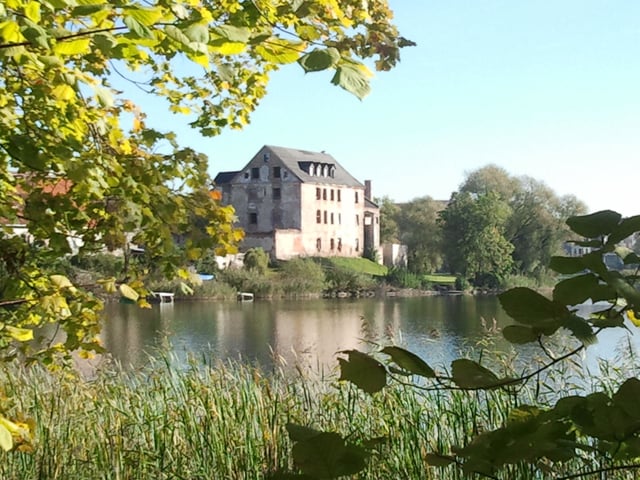
Old castle in Ełk
By 1283, the last Sudovian Prussian leader, Skomand (Lithuanian: Skalmantas), capitulated to the Teutonic Knights in the area. After 1323, the northern part of the region was administered by the Komturship of Brandenburg, while the larger part with the later town belonged to Komturship Balga. A former Old Prussian settlement, the town was first documented in 1398 around a castle built by the Teutonic Knights. The town's name has various postulated origins. Its German version Lyck is postulated to be derived from its Old Prussian name, Luks (from the word for waterlily, luka), while another theory holds that the name comes from Polish word "łęg" meaning meadow.[1] It received its town rights in 1445.
After the outbreak of the Thirteen Years' War in 1454, the town sided with the Prussian Confederation,[2] at whose request the Polish King Casimir IV Jagiellon announced the incorporation of the region into the Kingdom of Poland, which resulted in Lyck becoming part of the Polish state.[2] The town was briefly captured by the Teutonic Knights in 1455, and later on, it was conquered alternately by the Poles and the Teutonic Knights.[3] After 1466 it came under Polish suzerainty as a fief.[4]
Modern era
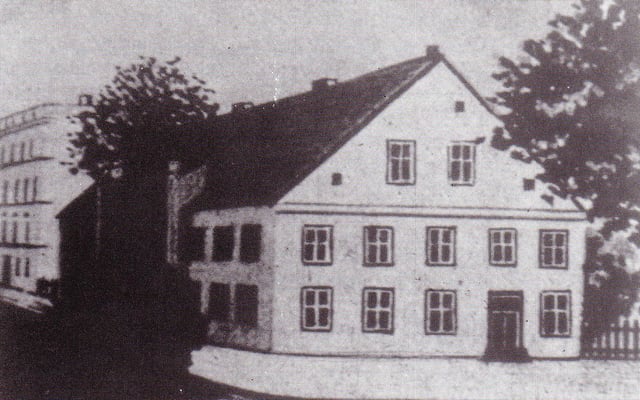
Old Gymnasium around 1830
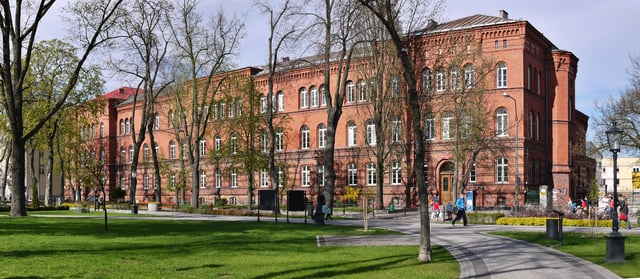
The court building, built in 1880, nowadays an elementary school
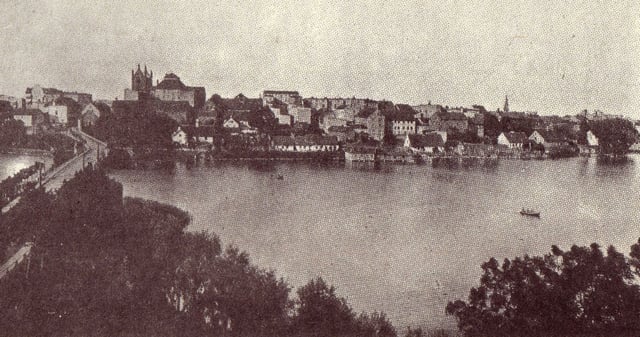
Ełk around 1900
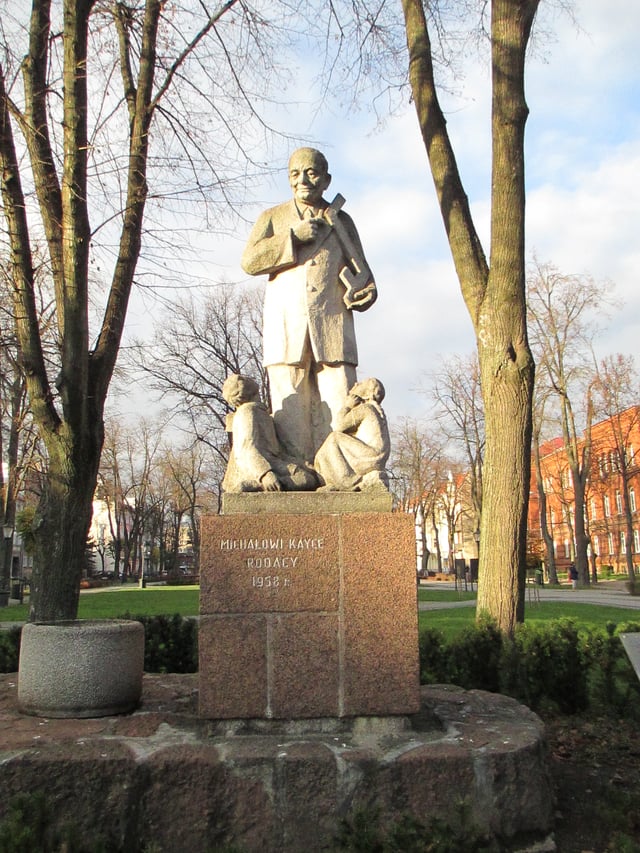
Michał Kajka monument in the Solidarity Park
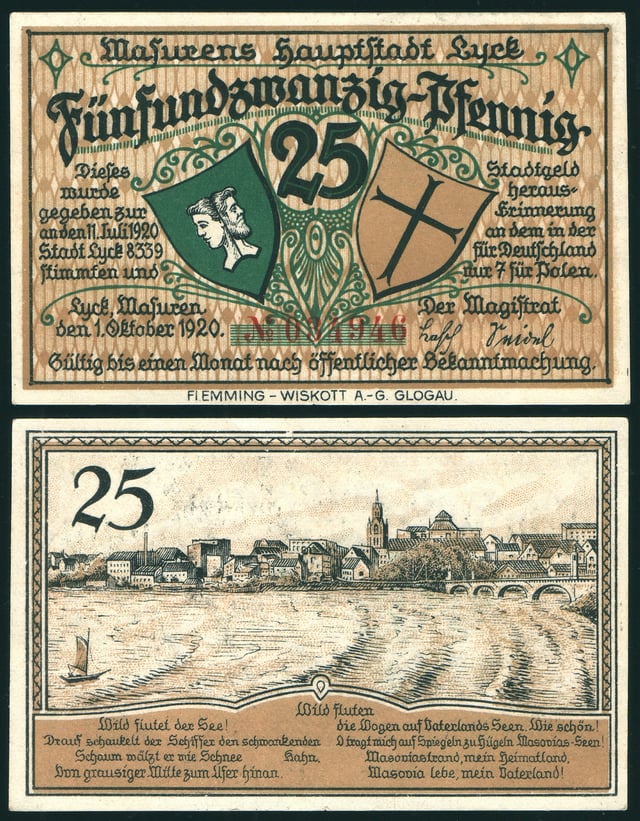
25 Pfennig Notgeld banknote of 1920 with a view of the town on the reverse
In 1537, Duke Albert of Prussia donated an estate to Jan Malecki, a Polish printer from Kraków who had either fled[5] or moved to Ducal Prussia for material reasons,[6] to establish a printing house.[7] After converting to Lutheranism, Malecki translated and published Martin Luther's Small Catechism in Polish[8] In 1546 the first school for secondary education in Masuria was founded in the city, where Polish nobles from the Polish–Lithuanian Commonwealth, as well as Poles and Germans from Ducal Prussia were taught in Polish; the position of a Polish teacher remained in place until 1819.[9] Polish pastor, translator, publisher and co-creator of the literary Polish language, Hieronim Malecki, was the school's first rector.[10] In the mid-16th century Lyck was one of the most thriving centers of Polish-language printing. In 1639 the King of Poland Władysław IV Vasa visited the town.[11] It remained under Polish suzerainty until 1660.[12]
In 1825, Lyck was inhabited by 1,748 Germans and 1,394 Poles.[15] At the beginning of the 19th century, a Polish-language school was organised in the city by Tymoteusz Gizewiusz[16] In 1820, Fryderyk Tymoteusz Krieger became the superintendent of the school and actively defended the rights of local Poles to use the Polish language. Kireger also prepared Polish educational programs, in opposition to attempts at Germanization by Prussian authorities.[17]
In 1840, the German-language newspaper "Lycker gemeinnütziges Unterhaltungsblatt", later called "Lycker Zeitung", was founded.[18] Between 1842 and 1845, a Masurian newspaper "Przyjaciel Ludu Łecki" (Łek's Friend of the People) was printed in the city, whose aim was to resist Germanisation and cultivate Polish folk traditions as well as educate the local rural population.[19][20]
In May 1845, a Polish resistance movement in the city was organized by Kazmierz Szulc, whose aim was to prepare local Polish youth for an uprising.[21]
In 1885 Lyck was named capital of Masuria by the Geographical Dictionary of the Kingdom of Poland.[22] In the late 19th century it was the largest town of the region (according to data from 1880 and 1890), before being surpassed by Osterode (Ostróda) (according to data from 1905 and 1925).
From 1896 to 1902, "Gazeta Ludowa", a Polish-language newspaper, heavily subsidised by banks from Greater Poland[23][24] representing the Polish national movement in Masuria, was published in the city.[25] It soon faced repression and discrimination from the German authorities which led to its demise;[26] its paid circulation dropped from 357 copies in 1896 to less than 250 at the turn-of-the-century.[27] According to German-American author, Richard Blanke, the "demise marked the end of the second major effort by Polish nationalists to establish a journalistic foothold in Masuria".[28]
In 1896, Polish and Masurian activists founded the Masurian People's Party in the city, which sought to resist efforts of German authorities at forced Germanization. The co-founder of the party was poet Michał Kajka, today honoured in Ełk with a monument in the centre of the city.[29] From the start, the party was subject to severe repressions and attacks by Prussian authorities.[30] In the German federal elections, the MPL received 229 votes in 1898 and 20 in 1912 in the Lyck constituency.[31]
In 1910, Lyck had more than 13,000 inhabitants.[32] Mateusz Siuchniński gives the percentage of Poles in 1900 as 35.7% but warns that the numbers come from lowered German estimates.[33] Many citizens fled during World War I, when Imperial Russian troops attacked the region, but returned after the battles of Tannenberg and the Masurian Lakes. English and Italian troops were deployed in the town after the Treaty of Versailles[34] to supervise the East Prussian plebiscite, which resulted in 8,339 votes for Germany and 8 for Poland.
It was in Lyck that the first-ever weekly newspaper in the Hebrew language, Ha-Magid ("the preacher") was founded in 1856 by Eliezer Lipmann Silbermann, a local rabbi. The paper was eventually moved to Berlin.[35] In Weimar Germany anti-Semitism became prevalent, which led to persecution of the local Jewish population even before the Nazis took power. An anti-Semitic publication, Die jüdische Überlegenheit (The Jewish Supremacy) attacking the Jews circulated in 1927 at a local gathering of fascist sympathizers[36] In 1932, the local pharmacist Leo Frankenstein was attacked; a hand grenade was thrown into his home.[37] The wave of anti-Semitic repressions intensified after Nazis gained power in Germany in 1933 and many local merchants and intellectuals of Jewish descent were arrested.[37] During Kristallnacht, Jewish shops and synagogue were plundered and devastated in the town.[37] Facing these events, several Jews of Lyck decided to escape, some abroad, some to Berlin, others as far as Shanghai[37] Of those Jews who remained, 80 were murdered in various Nazi concentration and death camps.[37]
The city also was the site of German prison camps for Norwegian and Soviet PoWs during World War II.[38][39] It was heavily damaged by bombardments. The county of Lyck had 53,000 inhabitants when the Soviet Army approached in January 1945. The town was placed under Polish administration in April 1945 and its German inhabitants were dispossessed and forcibly expelled. It was rebuilt and renamed Ełk (before 1939, Polish names for the town included Łek, Łęg and Łęk). In 1999, Ełk was visited by Pope John Paul II. About 300,000 people attended a papal Mass.
In 2017, the anti-Muslim Ełk riots occurred. Several hundred men surrounded the Prince Kebab restaurant,[40][41] tossing firecrackers, stones, and Molotov cocktails at the shop.[42] Police initially stood by and did not intervene for several hours; however, when they did intervene the crowd turned against them as well.[42] Following the riots in Ełk, other attacks on kebab restaurants took place throughout Poland.[42]
In 2018, on the occasion of the 100th anniversary of Poland's independence, a monument to Józef Piłsudski was erected in front of the town hall.[43] The Marshal of Poland was also honored with a mural on one of the townhouses in the city center.[44]
Population
Number of inhabitants by year
| Year | Number |
|---|---|
| 1499 | 600 |
| 1600 | 800 |
| 1782 | 2,000 |
| 1831 | 2,945 |
| 1875 | 5,912 |
| 1880 | 6,846 |
| 1890 | 9,981 |
| 1925 | 15,159 |
| 1933 | 15,512 |
| 1939 | 16,243 |
| 2010 | 61,156 |
| 2011 | 59,274 |
| 2017 | 61,523 |
Demographic changes 1910 – 2013
Districts
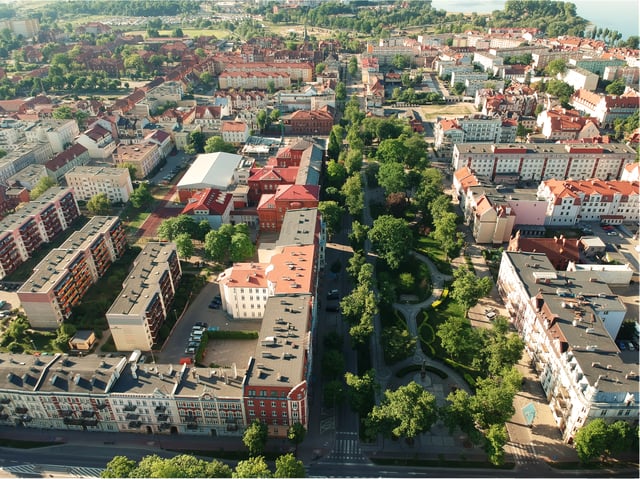
City centre and the Solidarity Park
The city of Ełk is divided into 13 administrative units, known in Polish as osiedla
Baranki
Centrum
Jeziorna
Konieczki
Osiedle Bogdanowicza
Osiedle Grunwaldzkie
Osiedle Kochanowskiego
Osiedle Tuwima
Osiedle Wczasowe
Pod Lasem
Północ I
Północ II
Szyba
Zatorze
Notable residents
Eliezer Lipmann Silbermann (1819–1882), Jewish publisher
Arthur Ludwich (1840–1920) a German classical philologist who specialized in Homeric studies
Charles Edward Moldenke (1860–1935) was an American Lutheran minister and Egyptologist
Theodor Simon Flatau (1860–1937), German physician
Karol Bahrke (1868–1935), Polish activist, journalist and book publisher
Otto von Schrader (1888–1945), German admiral
Theodor Horydczak, (1889-1971), American photographer
Alfred Müller (1905–1959) a German middle-distance runner, competed in the 1928 Summer Olympics
Kurt Symanzik (1923–1983), German physicist
Siegfried Lenz (1926–2014), German author, born in Lyck; honorary citizen of Ełk since 2011.[50]
Klaus Gerwien (born 1940), German soccer player
Leszek Błażyński (1949–1992), Polish boxer
Roman Czepe (born 1956), Polish politician
Andrzej Zgutczyński (born 1958), Polish footballer
Cezary Zamana (born 1967), Polish cyclist
Michał Olszewski (born 1977), Polish author
Paweł Sobolewski (born 1979), Polish footballer
Mayors
Adam Puza (1990–1994)
Zdzisław Fadrowski (1994–2002)
Janusz Nowakowski (2002–2006)
Tomasz Andrukiewicz (since 2006)
Education
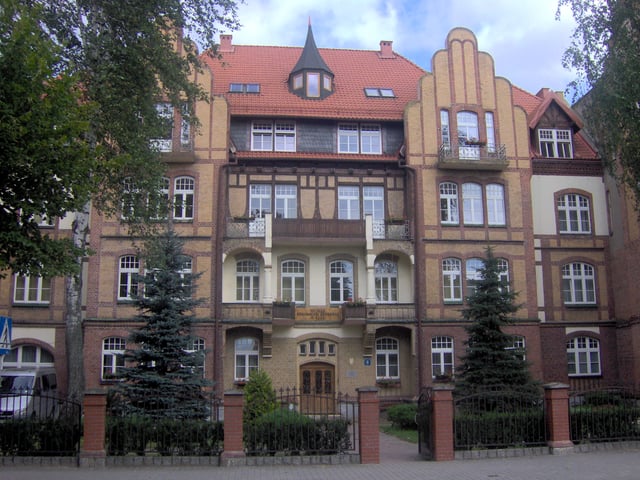
Higher Catholic Seminary
Private Economic Academy
Nursery School
Higher Catholic Seminary
University of Warmia and Mazury in Olsztyn
Academy of Finance and Management in Białystok
University of Economy in Bydgoszcz
High school
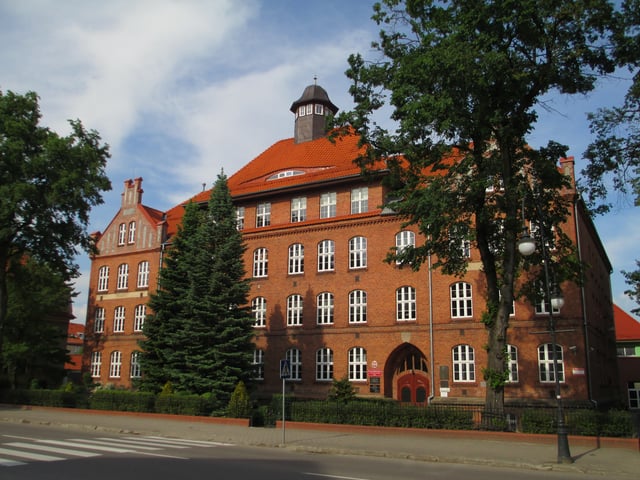
High school No. 1 in Ełk
Zespół Szkół Ekonomicznych [67]
Zespół Szkół Mechaniczno - Elektrycznych [68]
Zespół Szkół nr 1 [69]
Zespół Szkół nr 2 im. K. K. Baczyńskiego (swww [70] )
Zespół Szkół nr 3 im. J. H. Małeckich (www [71] )
I Liceum Ogólnokształcące im. S. Żeromskiego (www [72] )
Zespół Szkół Rolniczych im. M. Rataja
Zespół Szkół Samorządowych [73]
Zespół Szkół nr.6 im. M. Rataja (www) [74]
Religion
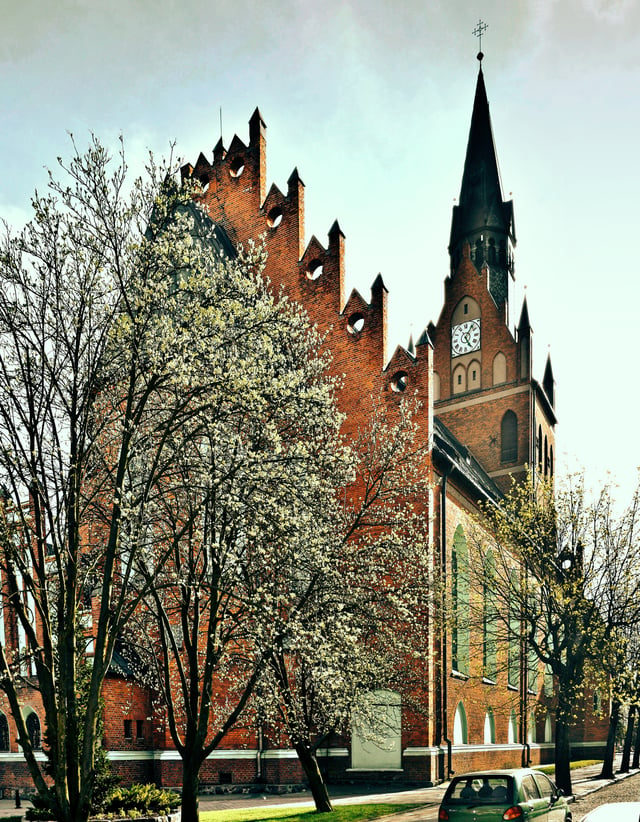
Sacred Heart Church in Ełk
Before World War II, the town and its surroundings were almost entirely (>95%) Lutheran.[51] After the German populace fled or was expelled, the main religion in Ełk became Roman Catholicism, although a number of Protestant churches are also represented and play an important role in the religious life of the population. These include the Methodist, Baptist, Pentecostal (Assemblies of God - Kościół Zielonoświątkowy) and other churches. Ełk is the center of the Catholic Diocese of Ełk with its bishop Jerzy Mazur.
International relations
Twin towns and sister cities
Ełk is twinned with:
[[INLINE_IMAGE|//upload.wikimedia.org/wikipedia/en/thumb/b/ba/Flag_of_Germany.svg/23px-Flag_of_Germany.svg.png|//upload.wikimedia.org/wikipedia/en/thumb/b/ba/Flag_of_Germany.svg/35px-Flag_of_Germany.svg.png 1.5x, //upload.wikimedia.org/wikipedia/en/thumb/b/ba/Flag_of_Germany.svg/46px-Flag_of_Germany.svg.png 2x|Germany|h14|w23|thumbborder flagicon-img flagicon-img]] Hagen, Germany
[[INLINE_IMAGE|//upload.wikimedia.org/wikipedia/commons/thumb/8/85/Flag_of_Belarus.svg/23px-Flag_of_Belarus.svg.png|//upload.wikimedia.org/wikipedia/commons/thumb/8/85/Flag_of_Belarus.svg/35px-Flag_of_Belarus.svg.png 1.5x, //upload.wikimedia.org/wikipedia/commons/thumb/8/85/Flag_of_Belarus.svg/46px-Flag_of_Belarus.svg.png 2x|Belarus|h12|w23|thumbborder flagicon-img flagicon-img]] Lida, Belarus
[[INLINE_IMAGE|//upload.wikimedia.org/wikipedia/en/thumb/b/ba/Flag_of_Germany.svg/23px-Flag_of_Germany.svg.png|//upload.wikimedia.org/wikipedia/en/thumb/b/ba/Flag_of_Germany.svg/35px-Flag_of_Germany.svg.png 1.5x, //upload.wikimedia.org/wikipedia/en/thumb/b/ba/Flag_of_Germany.svg/46px-Flag_of_Germany.svg.png 2x|Germany|h14|w23|thumbborder flagicon-img flagicon-img]] Nettetal, Germany
[[INLINE_IMAGE|//upload.wikimedia.org/wikipedia/commons/thumb/1/11/Flag_of_Lithuania.svg/23px-Flag_of_Lithuania.svg.png|//upload.wikimedia.org/wikipedia/commons/thumb/1/11/Flag_of_Lithuania.svg/35px-Flag_of_Lithuania.svg.png 1.5x, //upload.wikimedia.org/wikipedia/commons/thumb/1/11/Flag_of_Lithuania.svg/46px-Flag_of_Lithuania.svg.png 2x|Lithuania|h14|w23|thumbborder flagicon-img flagicon-img]] Nemenčinė, Lithuania
[[INLINE_IMAGE|//upload.wikimedia.org/wikipedia/en/thumb/a/a4/Flag_of_the_United_States.svg/23px-Flag_of_the_United_States.svg.png|//upload.wikimedia.org/wikipedia/en/thumb/a/a4/Flag_of_the_United_States.svg/35px-Flag_of_the_United_States.svg.png 1.5x, //upload.wikimedia.org/wikipedia/en/thumb/a/a4/Flag_of_the_United_States.svg/46px-Flag_of_the_United_States.svg.png 2x|United States|h12|w23|thumbborder flagicon-img flagicon-img]] Burlington, Vermont, United States
[[INLINE_IMAGE|//upload.wikimedia.org/wikipedia/en/thumb/0/03/Flag_of_Italy.svg/23px-Flag_of_Italy.svg.png|//upload.wikimedia.org/wikipedia/en/thumb/0/03/Flag_of_Italy.svg/35px-Flag_of_Italy.svg.png 1.5x, //upload.wikimedia.org/wikipedia/en/thumb/0/03/Flag_of_Italy.svg/45px-Flag_of_Italy.svg.png 2x|Italy|h15|w23|thumbborder flagicon-img flagicon-img]] Galatone, Italy
[[INLINE_IMAGE|//upload.wikimedia.org/wikipedia/en/thumb/0/03/Flag_of_Italy.svg/23px-Flag_of_Italy.svg.png|//upload.wikimedia.org/wikipedia/en/thumb/0/03/Flag_of_Italy.svg/35px-Flag_of_Italy.svg.png 1.5x, //upload.wikimedia.org/wikipedia/en/thumb/0/03/Flag_of_Italy.svg/45px-Flag_of_Italy.svg.png 2x|Italy|h15|w23|thumbborder flagicon-img flagicon-img]] Orbassano, Italy
[[INLINE_IMAGE|//upload.wikimedia.org/wikipedia/en/thumb/f/f3/Flag_of_Russia.svg/23px-Flag_of_Russia.svg.png|//upload.wikimedia.org/wikipedia/en/thumb/f/f3/Flag_of_Russia.svg/35px-Flag_of_Russia.svg.png 1.5x, //upload.wikimedia.org/wikipedia/en/thumb/f/f3/Flag_of_Russia.svg/45px-Flag_of_Russia.svg.png 2x|Russia|h15|w23|thumbborder flagicon-img flagicon-img]] Ozyorsk, Russian Federation
Coat of arms

Old coat of arms
The current coat of arms of Ełk were adopted in 1999, after the town was visited by the Pope John Paul II. The colors have been changed (from green to yellow), the deer is different than in the former emblem. Lastly is the addition of the insignia of the Papacy.
Until 1967, a different emblem with the two-faced head of the god Janus was used, but its origin is unknown.[52]








